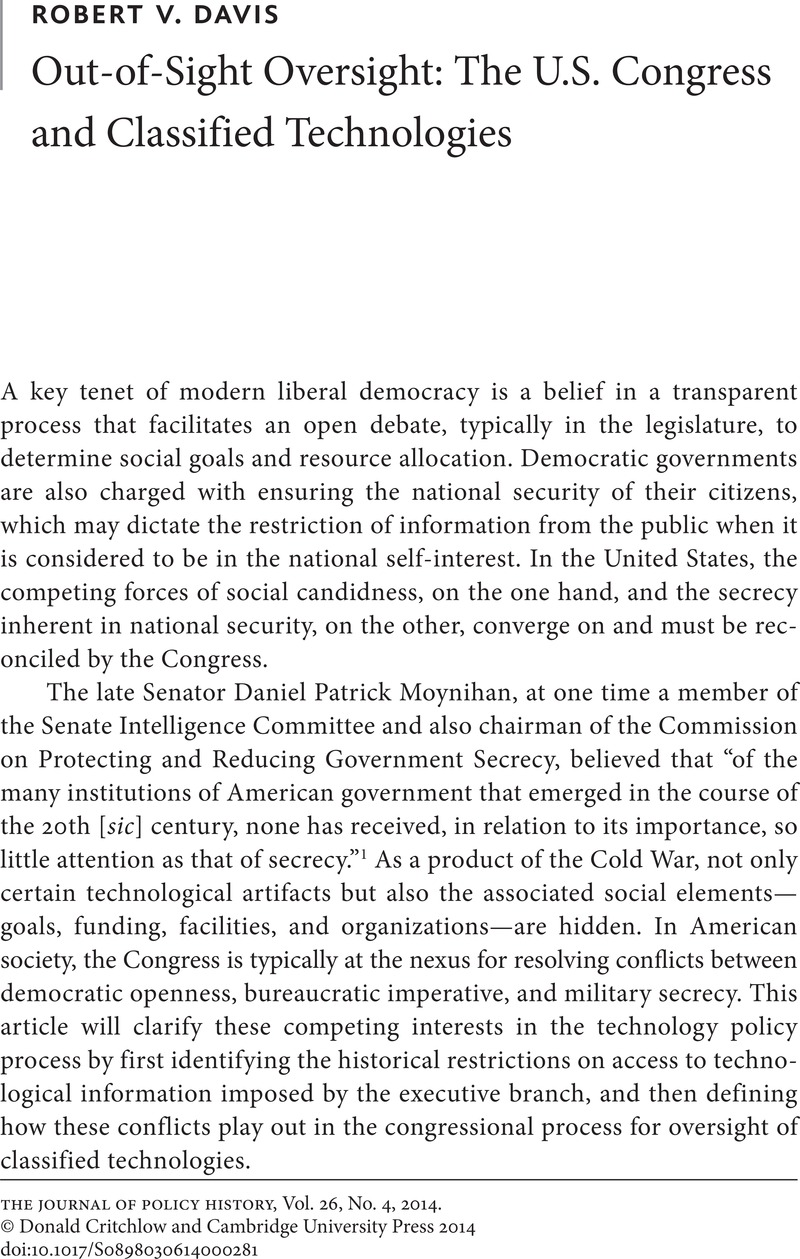No CrossRef data available.
Published online by Cambridge University Press: 02 September 2014

1. Daniel Patrick Moynihan, “The Science of Secrecy,” 29 March 1999, American Association for the Advancement of Science, 1, http://www.aaas.org/spp/secrecy/Presents/Moynihan.htm.
2. Lloyd, G. E. R., Magic, Reason, and Experience: Studies in the Origins and Development of Greek Science (Cambridge, 1979), 61.Google Scholar
3. McMullin, Ernan, “Openness and Secrecy in Science: Some Notes on Early History,” Science, Technology, & Human Values 10, no. 2, “Secrecy in University-Based Research: Who Controls: Who Tells?” (Spring 1985): 14–23.CrossRefGoogle Scholar
4. Long, Pamela O., Openness, Secrecy, Authorship: Technical Arts and the Culture of Knowledge from Antiquity to the Renaissance (Baltimore, 2001).Google Scholar
5. Jasanoff, Sheila, “Ordering Knowledge, Ordering Society,” in States of Knowledge, ed. Jasanoff, Sheila (New York, 2007), 32.Google Scholar
6. Pallitto, Robert M. and Weaver, William G., Presidential Secrecy and the Law (Baltimore, 2007), 93.Google Scholar
7. Executive Order 13292 in 2003 (George H. Bush) and 13526 in 2009 (Barack Obama).
8. Executive Order 10816 in 1959 (Dwight D. Eisenhower).
9. The titles are National Security Action Memorandum (John Kennedy and Lyndon Johnson); National Security Decision Memorandum (Richard Nixon and Gerald Ford); Presidential Directive (Jimmy Carter); National Security Decision Directive (Ronald Reagan); National Security Directive (George H. W. Bush); Presidential Decision Directive (Bill Clinton); National Security Presidential Directive (George W. Bush); and Presidential Policy Directive (Barack Obama). After September 11, 2001, the Bush and Obama administrations also began promulgating a new Homeland Security Presidential Directive. Throughout the above administrations, there were also, from time to time, nondecision directives relating to national security studies and reviews such as that in the Obama administration called Presidential Study Directive.
10. Herbert Foerstel, Secret Science: Federal Control of American Science and Technology (Westport, Conn., 1993), 32.
11. Ibid., 22.
12. Pallitto and Weaver, Presidential Secrecy and the Law, 6.
13. Department of Navy v. Egan, a frequently cited 1988 U.S. Supreme Court decision.
14. Pallitto and Weaver, Presidential Secrecy and the Law, 112–13.
15. Daniel Patrick Moynihan, Secrecy: The American Experience (New Haven, 1998), 158.
16. Bruce Berkowitz, “Are Our Intelligence Agencies So Obsessed with Keeping Secrets That They Are Actually Putting Us at Risk?” National Security: Secrecy and National Security, Hoover Digest, no. 3, 2004 http://www.hoover.org/publications/digest/3020376.html.
17. Sheila Jasanoff, “Ordering Knowledge, Ordering Society,” 33.
18. Avalon Project at Yale Law School, “Constitution of the United States,” 1787, http://avalon.law.yale.edu/18th_century/art1.asp.
19. Pallitto and Weaver, Presidential Secrecy and the Law, 2.
20. Guston, David H., Between Politics and Science: Assuring the Integrity and Productivity of Research (Cambridge, 2007), 25.Google Scholar
21. Avalon Project at Yale Law School, “Resolution of Secrecy Adopted by the Continental Congress, November 9, 1775,” quoting from “Secret Journals of the Acts and Proceedings of U.S. Congress,” vol. 1, p. 34, http://www.yale.edu/lawweb/avalon/sonct/const01.htm.
22. Avalon Project at Yale Law School, “Constitution of the United States.”
23. Mildred Amer, “Secret Sessions of Congress: A Brief Historical Overview,” CRS Report for Congress, Washington, D.C., 21 October 2004.
24. Price, Don K., The Scientific Elite (Cambridge, Mass., 1965), 5.Google Scholar
25. John Pike and Steven Aftergood, “History of Mystery Aircraft,” 10, Federation of American Scientists: Intelligence Resource Program, http://www.fas.org/irp/mystery/history.htm.
26. Frederick M. Kaiser, “Protection of Classified Information by Congress: Practices and Proposals,” CRS Report for Congress (Washington, D.C.), 11 January 2006, 4.
27. Ibid.
28. David Dickson, The New Politics of Science (Chicago, 1984), 6.
29. Pike and Aftergood, “History of Mystery Aircraft,” 10.
30. Beck, Ulrich, Risk Society: Towards a New Modernity (London, 1992), 192.Google Scholar
31. Kaiser, “Protection of Classified Information by Congress.
32. Moynihan, “The Science of Secrecy,” 3.
33. U.S. Congress. H.R. 4576, Department of Defense Appropriations Act, 2001, http://thomas.loc/gov. There are three committees in each of the House and the Senate with such oversight responsibilities. For Defense Department programs, both the Armed Services Committees and the Defense Appropriations Subcommittees have authorization and appropriations oversight, respectively. For Intelligence Community programs, the Intelligence Committees and, again, the Defense Appropriations Subcommittees have authorization and appropriations oversight, respectively.
34. U.S. Congress H.R. 4650, 1995, U.S. Congress. H.R. 4650, Department of Defense Appropriations Act, 1995, http://thomas.loc/gov.
35. Gary L. Kepplinger, General Counsel, U.S. Government Accountability Office, letter (B- 316010) dated 25 February 2008 to Senators Robert C. Byrd and Thad Cochran, “Consolidated Appropriations Act, 2008—Incorporation by Reference.”
36. U.S. Congress, House Committee on Oversight and Government Reform, “Secrecy in the Bush Administration,” undated, http://oversight.house.gov/features/secrecy.
37. Kunkle, Gregory C., “New Challenge or the Past Revisited? The Office of Technology Assessment in Historical Context,” Technology in Society 17, no. 2 (1995): 175–96.CrossRefGoogle Scholar
38. R. W. Vandergrift Jr., retired chief, Surveys and Investigations Staff, House Committee on Appropriations, e-mail dated 10 April 2008.
39. Hart, David M., Forged Consensus: Science, Technology, and Economic Policy in the United States, 1921–1953 (Princeton, 1998), 9.Google Scholar